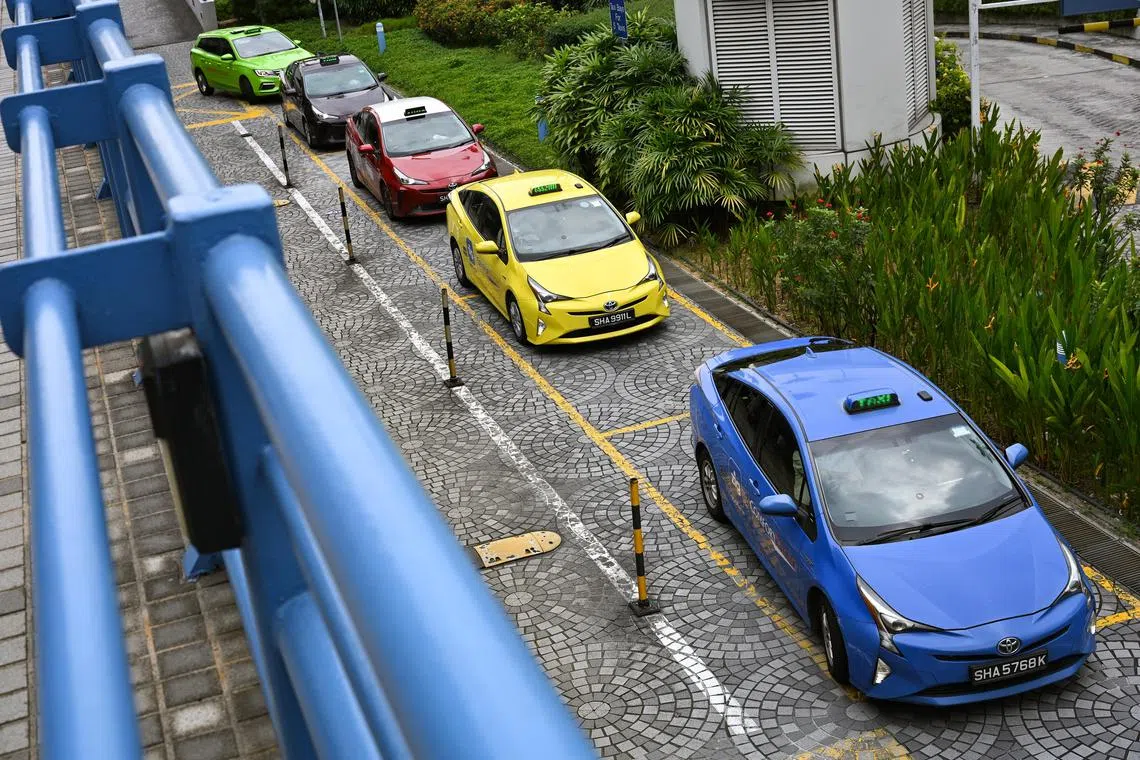Taxi operators to be allowed to sell cabs over 3 years old, convert used cars to taxis
Sign up now: Get ST's newsletters delivered to your inbox

To allow the replacement and growth of taxi fleets, the suspension of a 2 per cent cap on annual taxi fleet growth will remain.
ST PHOTO: LIM YAOHUI
Follow topic:
SINGAPORE - Taxi companies will be allowed to sell taxis that are more than three years old – capped at 5 per cent of their fleet per year – and convert used vehicles under five years old into taxis, subject to approval from the Land Transport Authority (LTA).
These are among the latest revisions to the point-to-point transport (P2P) sector, comprising taxi and private-hire car (PHC) services, aimed at helping companies manage costs and stemming the continued decline in Singapore’s taxi population.
During the debate on the Ministry of Transport’s (MOT) budget in Parliament on March 5, Senior Minister of State for Transport Amy Khor said these are moves to further level the playing field between taxis and PHCs.
They also give taxi operators greater flexibility in managing costs and growing their fleets.
To allow the replacement and growth of taxi fleets, the suspension of a 2 per cent cap on annual taxi fleet growth – in place since 2021 after Covid-19 hit – will remain.
Dr Khor said allowing the sale of cabs that are more than three years old will enable operators to sell under-used taxis and reduce the costs of holding on to them.
“This added flexibility can also reduce operators’ risks when trialling new taxi models, such as bigger, more expensive multi-purpose vehicles, which can better serve larger families,” she added.
LTA told The Straits Times that taxis must be converted to other schemes, such as that for private cars, for an operator to sell them and that the 10-year statutory lifespan of taxis will continue to apply to the vehicles after conversion.
Meanwhile, the conversion of used vehicles into cabs will give taxi operators another option to grow their fleets, Dr Khor said.
Such vehicles have to meet LTA’s standards, including passing inspections for roadworthiness and meeting taxi-related requirements such as minimum boot space, LTA said.
Mr Ang Wei Neng (West Coast GRC), who is chief executive of taxi operator Strides Premier, said PHCs have “significant advantages” over taxis.
Instead of requiring taxis to be painted in the operators’ colours, he proposed identifying them with a removable taxi top and an LCD (liquid crystal display) sign. This is so that the vehicles can be used for other purposes when not providing taxi services, thus levelling the playing field with PHCs.
Dr Khor said taxis remain an important part of meeting passenger demand. They are a more stable source of supply for P2P transport, she added, noting that one-shift taxis spend a median of 49 active hours a week providing such trips, compared with 34 hours for PHCs.
The number of taxis in Singapore has fallen from around 28,700 in 2014 to 13,000 at the end of January 2025, according to the latest available data from LTA.
Separately, PHCs registered with certificates of entitlement secured from March 5 onwards will have to disclose their history of being used as such vehicles. This applies to all PHCs that are newly registered, converted out of the scheme to be passenger cars, or transferred to others.
Taxis that are sold are also subject to the disclosure requirement.
Dr Khor said the move will improve transparency in the resale market, and further encourage the registration of such vehicles for their intended purposes.
“We expect the impact of the measure to be manageable, as the majority of bona fide PHC leasing companies already keep their vehicles for more than three years,” she added.
ComfortDelGro, Singapore’s largest taxi company, said the measures will help the company to better manage fleet costs, and balance the “competitive landscape between taxis and private-hire cars”.
When asked how likely they would look to convert used cars into cabs or sell their older taxis, Trans-Cab and Prime said it is too early to tell, noting that much will depend on market conditions.
Ms Jasmine Tan, general manager of Trans-Cab, said that for the conversion of used cars into cabs to make sense, there must be sufficient numbers of the same used-car model in its taxi fleet to achieve the economies of scale when it comes to maintenance.
She said the sale of taxis may be difficult because, on average, a three-year-old taxi may have covered around 300,000km, compared with about 40,000km for a private car, making taxis less attractive to buyers.
Mr Neo Nam Heng, chairman of diversified motor group Prime, which owns Prime Taxi, said the used-car market will likely evolve to a point where former taxis and private-hire cars are accepted and sold at a lower price than private cars.
The industry veteran welcomed the greater flexibility, but hopes that more can be done to increase the supply of taxi drivers and improve the availability of cabs for street hailing.
The announcements on March 5 follow a move on Feb 19 requiring companies to keep their PHCs meant for ride-hailing services for three years
Before this, companies could freely sell their private-hire cars to other companies or convert them out of the scheme to become passenger cars.
The latest changes will be rolled out after LTA works out the arrangements with operators, the National Taxi Association and National Private Hire Vehicles Association. They are part of the second phase of a government review of the P2P transport sector announced in September 2023.
On the ride-hailing front, LTA said large operators will be subject to extra responsibilities, including higher data disclosure obligations. Large operators refer to those with wider driver and commuter networks, which enable them to “benefit from network effects, and influence market norms,” said LTA.
This is intended to prevent practices that limit choices for drivers and passengers.
No further details were given. LTA said it will consult the sector in designing the additional requirements.
Separately, users of ride-hailing services can look forward to nine “P2P stops” in the Central Business District, where they can get on or off private-hire cars and taxis.
These are currently the most frequently used taxi stops in the area. The conversion to P2P stops will start with E19 in Shenton Way outside OUE Downtown, and E13 at 9 Battery Road.
This will make pick-ups and drop-offs safer and more convenient for passengers using such services, said LTA. The stops will have signs and markings indicating that they are for taxis and PHCs, and waiting is not allowed.
These upcoming P2P stops are distinct from taxi stands, which remain reserved only for taxis and where cab drivers can queue to pick up passengers.
Ride-hailing company Gojek said it is supportive of any efforts that improve transport accessibility, including the P2P stops, which will help to create a more seamless experience for its customers.
Recognising the need for the P2P sector to cater to the changing needs of the population, Dr Khor said MOT is inviting operators to come up with ideas that can make their services more accessible to commuter groups such as seniors.
“LTA will provide co-funding of up to 50 per cent, capped at $500,000, for the development of viable ideas via the P2P Inclusivity Co-funding Grant,” she said.
The agency said solutions could take the form of improved app features or a standalone senior-friendly ride-booking app.
This follows a survey LTA carried out with seniors, where navigating ride-hailing apps was the most commonly cited challenge.
The latest changes come after an earlier set of updates to the P2P sector
Those included lengthening the statutory lifespan of non-electric taxis from eight to 10 years and removing the requirement for smaller taxi operators to maintain a call-booking system.
Lee Nian Tjoe is senior transport correspondent at The Straits Times, where he also oversees the Motoring section.


